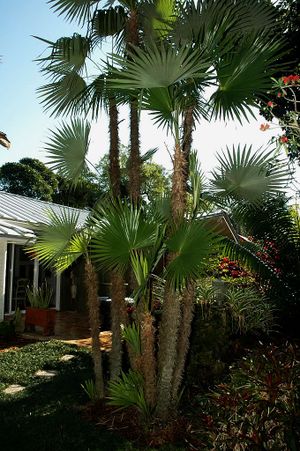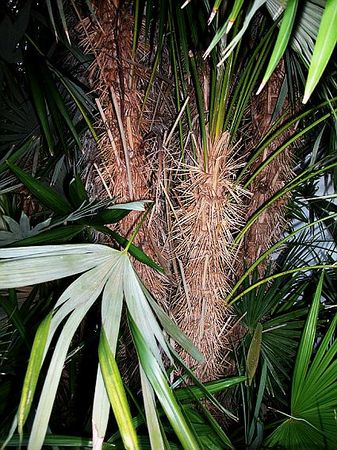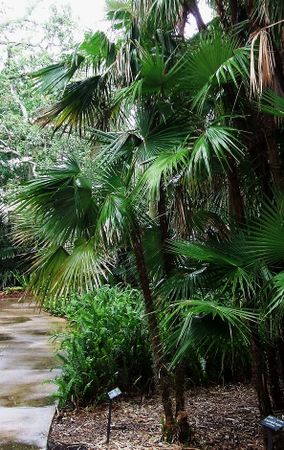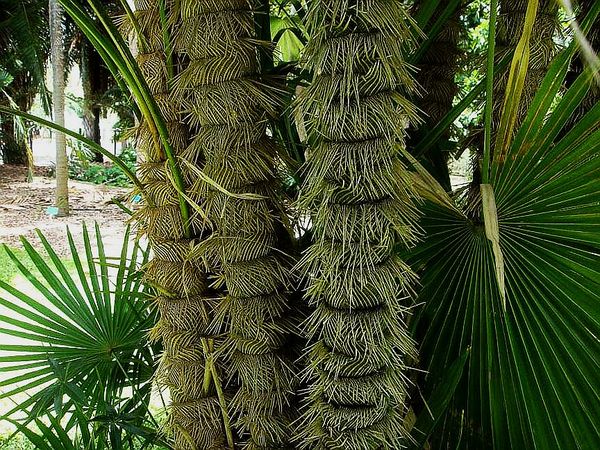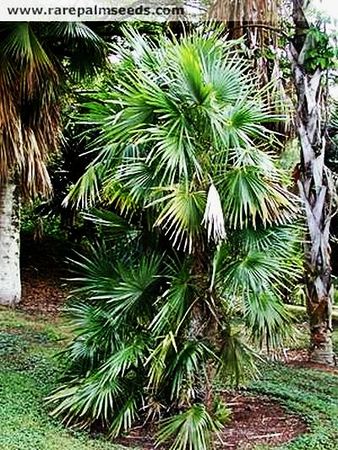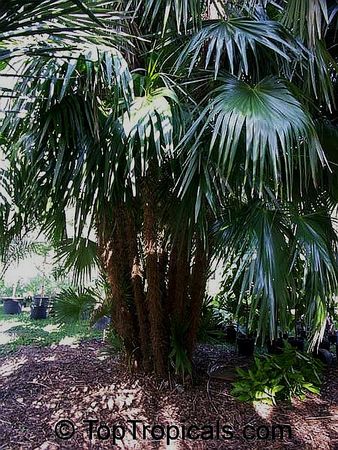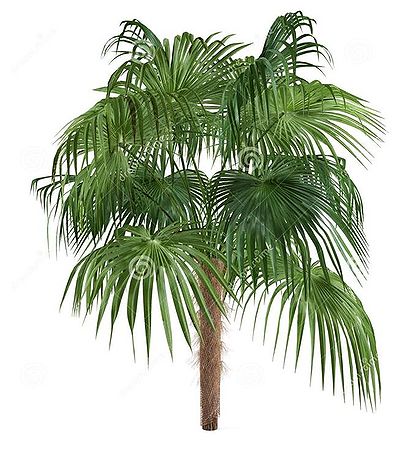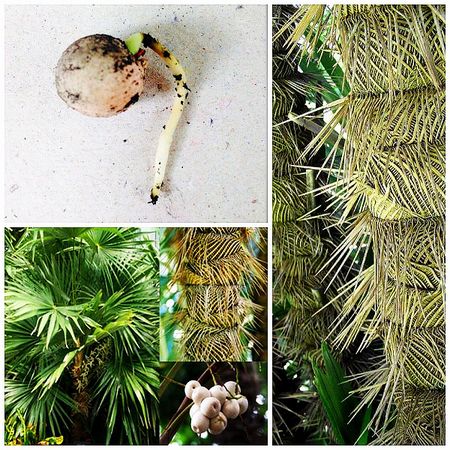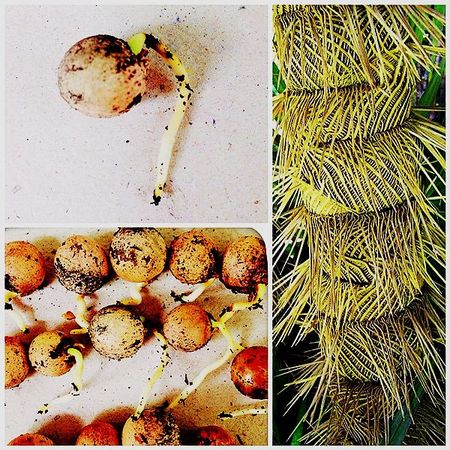Zombia antillarum
| Zombia (ZOHM-bee-ah) Antillarum (ahn-TIHL-lahr-uhm) | ||||||||
|---|---|---|---|---|---|---|---|---|
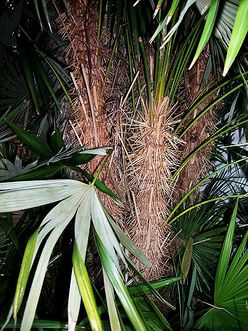 Montgomery Botanical Center, Florida. Photo by Dr. John Dransfield, Royal Botanic Gardens, Kew/Palmweb. | ||||||||
| Scientific Classification | ||||||||
| ||||||||
| Synonyms | ||||||||
|
| ||||||||
| Native Continent | ||||||||
|
| ||||||||
| Morphology | ||||||||
| ||||||||
| Culture | ||||||||
| ||||||||
| Survivability index | ||||||||
|
| ||||||||
| Common names | ||||||||
|
| ||||||||
Contents
Habitat and Distribution
Zombia antillarum is endemic to the island of Hispaniola. Open scrub on dry hills.
Description
The thatched leaf stems of zombie palm are lined with long, vicious spines that are said to be used as voodoo doll needles. This unusual, dryland palm is clump-forming and native to the Caribbean island of Hispañola, which houses the independent states of Haiti and the Dominican Republic. Wild populations are not common but typically found growing along dry, forested slopes and ridges. On occasion, specimens can be found in moister, lowland sites.
The many upright trunks of zombie palm are heavily cloaked in fibers and downward pointing, spine-like "needles" borne in spiraled rings. The leaf fronds are fan-like, glossy or dull green on top and silvery gray-green beneath. In summer, a short clustered stem of tiny white flowers will appear from the crownshaft of each trunk among the fronds. Bees and other insects visit the blossoms and attractive white, grape-sized fruits follow. (learn2grow.com)
Zombia antillarum is a small palm which grows in dense, multi-stemmed clumps with stems up to 3 metres (10 ft) tall and 5 centimetres (2 in) in diameter. Individuals bear nine to 12 fan-shaped (or palmate) leaves which are greyish-white on the lower surface. The leaf sheaths remain attached to the stem after the leaf drops off. The intervening tissue gradually degrades, and the woody vascular tissue splits, forming the spines which are characteristic of the species. The inflorescence, which is shorter than the leaves, bears bisexual flowers with 9–12 stamens and a single carpel. Fruit are white in colour (although orange-fruited individuals are also known to exist), oblong or pear-shaped, 1.5–2 cm (0.6–0.8 in) in diameter and bear a single seed. The flowers and fruit are borne among the leaves due to the fact that the inflorescences are shorter than the leaves. Trees can produce 5000 seeds per year, predominantly in July and August. The species is believed to be wind pollinated.
| Detailed Scientific Description |
|---|
|
Stems: Clustering, upright stems to 3 m tall and 5 cm in diameter, covered with stout, burlap-like leaf bases ringed with downturned, spiny, reticulate fibers. Leaves: Palmate, induplicate, to 90 cm wide, with blade divided more than half its length by numerous, lanceolate segments. Upper leaf surface, bright green; undersurface, grayish white to silver with a prominent midrib; leaf tips, slightly drooping and bifid for 1 cm or less. The slender petiole has no spines or teeth and is not split at the base; the hastula has three points (trident-like). Flowers and fruits: Inflorescences are branched to two orders and are shorter than the leaves. Flowers are small, creamy white and bisexual. Fruits are spherical to oblong, 1.5-2 cm in diameter, and white when ripe. (idtools.org) In 1960 Dominican botanist José de Jesús Jiménez Almonte described a variety of Z. antillarum which was distinguished from the typical variety by its smaller, pear-shaped fruits with a "dirty yellow" colour. He named this variety Z. antillarum var. gonzalezii. |
Culture
Cold Hardiness Zone: 10a
Grow zombie palm in full to partial sun and well-drained, sandy soil. It is very drought tolerant, but growth is more robust if plants are given regular moisture during the growing season. Occasionally trim off the lower fronds so the beauty of the trunks can be viewed more easily. Wild populations of this slow-growing palm are threatened in Haiti due to habitat destruction and livestock damage.
This is not an ornamental palm for areas where children frequent, but it is beautiful and ideal for Oceanside gardens and landscapes. Its spined trunks are one of its more visually appealing features, but they can puncture skin easily, so it’s best to situate zombie palm away from areas where people frequent to prevent unexpected run-ins. (learn2grow.com)
"Extremely slow growing fan palm with fascinating spiny trunk (large, thick spines arranged pointing downward) related to Coccothrinax palms. Does best in very warm climates, and even better in humid ones (Miami great climate, Palm Springs OK climate, Los Angeles marginal). I had a seedling for many years that grew maybe to 8" tall. Got bud rot once in a cold winter (down to 24F) but didn't die and eventually grew out of it. Takes this palm in Southern California ideal conditions about 15 years to start making a trunk." (Geoff Stein)
Comments and Curiosities
| read more |
|---|
|
This is a monotypic genus. The earliest description of the species is found in the work of French physician and botanist Michel Étienne Descourtilz. In 1821 he placed it in the genus Chamaerops as C. antillarum.[10] Italian naturalist Odoardo Beccari independently described the species in 1908, placing it in the genus Coccothrinax (as C. anomala). Recognising that it was distinct enough to be placed in its own genus, American botanist Liberty Hyde Bailey erected the genus Zombia in 1931 to accommodate the species that Descourtilz had described. This generated the combination Z. antillarum. In selecting a name for the genus, Bailey noted that it would be preferable if this endemic palm could bear a Latin name indicative of its nativity rather than an exotic binomial of no relation with its country and the people. In 1941 another American botanist, Orator F. Cook, moved Beccari's C. anomala to a new genus, Oothrinax. This generated a fourth combination, O. anomala. Since Descourtilz's description pre-dates that of Beccari, Zombia antillarum (which is based on Descourtilz's description) has priority over Oothrinax anomala. In addition, Cook's name is invalid, since it was apparently never formally described. In the first edition of Genera Palmarum (1987), Natalie Uhl and John Dransfield placed the genus Zombia in the subfamily Coryphoideae, the tribe Corypheae and the subtribe Thrinacinae using Harold E. Moore's 1973 classification of the palm family. Subsequent phylogenetic analysis showed that the Old World and New World members of the Thrinacinae were not closely related. As a consequence of this, Zombia and related genera were places in their own tribe, Cryosophileae. Within this tribe, Zombia appears to be most closely related to the genera Coccothrinax and Hemithrinax, and the species Thrinax morrisii, with the remainder of the genus Thrinax being a sister taxon to this group. Because of this, T. morrisii was moved to a new genus, Leucothrinax.
|
- IMAGE GALLERY
External Links
- Glossary of Palm Terms
- MODERN BOTANICAL LATIN
- "Just To Be Clear"
- http://www.palmbeachpalmcycadsociety.com/palms/documents/ZombiaAntillarum.pdf
- http://idtools.org/id/palms/palmid/factsheet.php?name=Zombia+antillarum
- https://www.youtube.com/watch?v=L_2bcNzEbbE
References
Phonetic spelling of Latin names by edric
Special thanks to Geoff Stein, (Palmbob) for his hundreds of photos.
Special thanks to Palmweb.org, Dr. John Dransfield, Dr. Bill Baker & team, for their volumes of information and photos.
Glossary of Palm Terms; Based on the glossary in Dransfield, J., N.W. Uhl, C.B. Asmussen-Lange, W.J. Baker, M.M. Harley & C.E. Lewis. 2008. Genera Palmarum - Evolution and Classification of the Palms. Royal Botanic Gardens, Kew. All images copyright of the artists and photographers (see images for credits).
Many Special Thanks to Ed Vaile for his long hours of tireless editing and numerous contributions.

